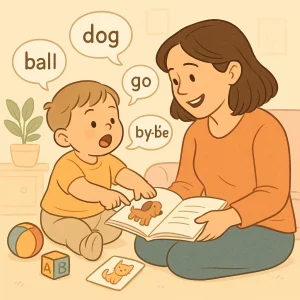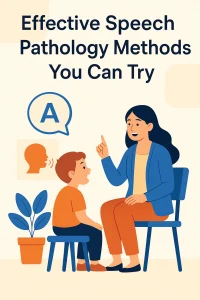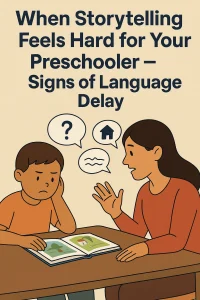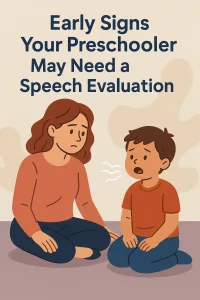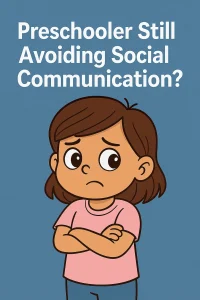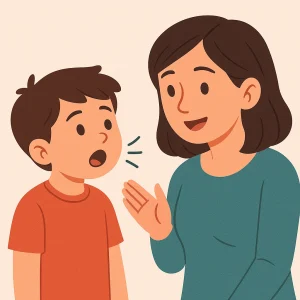Understanding Stuttering in Young Children: A Guide for Parents
By Rajini D
Last Updated: February 15, 2024
Our goal here is clear and simple: to offer you, the parent, a deep understanding of stuttering in young children and to arm you with actionable strategies to effectively support your child. Whether you’re observing the first signs of stuttering or seeking ways to help your child navigate through it, this article is designed to guide you every step of the way.
Coming from a place of care and expertise, we aim to speak directly to you, the concerned parent. We understand that behind every question about stuttering lies a deep desire to help your child communicate freely and confidently. With that in mind, we’ve crafted this guide to be as accessible, insightful, and supportive as possible. Let’s embark on this journey together, fostering an environment where your child can thrive, stutter-free.
Explore our article on Communication Difficulties in Children
Understanding Stuttering in Preschoolers
Stuttering in early childhood refers to the disruptions in the flow of speech, such as repetitions of sounds, syllables, or words, prolongations of sounds, and interruptions in speech known as blocks. These disruptions may be accompanied by physical tension or struggle in speaking.
It’s crucial to distinguish between normal disfluency and stuttering, as they are part of speech development. Normal disfluency occurs as young children, particularly toddlers, learn to use language and speech to communicate. Their efforts to grasp new words and form sentences can lead to hesitations, revisions, and the use of filler words like “um” and “uh.” This is a natural part of language learning and growth, often peaking between the ages of 2 and 5—a phase we might refer to as toddler stuttering.
However, stuttering differs in that it may include more frequent and pronounced disruptions in speech. These can be more noticeable and consistent over time, possibly affecting the child’s ability to communicate effectively and confidently. It’s here that parents might start to notice patterns that go beyond the typical trial and error of speech development.
Understanding this distinction is key, but knowing it doesn’t make it any less worrying when you observe it in your child. It’s natural to feel concerned, but remember, you’re not alone. Many families are navigating this journey, and support is available. Recognizing the early signs of stuttering is the first step towards supporting your child’s communication development. It opens the door to a range of supportive strategies and professional guidance, ensuring that your child can express themselves freely and confidently. This is a natural part of language learning and growth, often peaking between the ages of 2 and 5.
Stuttering Myths vs. Facts
| Myth | Fact |
|---|---|
| Stuttering is caused by nervousness. | Stuttering is a complex speech disorder with contributions from genetics, neurophysiology, and environmental factors, not simply nervousness. |
| Only boys stutter. | While stuttering is more common in boys, girls can also stutter. The gender difference in stuttering prevalence does not mean it’s exclusive to one gender. |
| Stuttering is a result of bad parenting. | Stuttering is not caused by parenting styles. It’s a speech disorder that is influenced by various biological and genetic factors. |
| People who stutter are not as intelligent. | There is no link between stuttering and intelligence. People who stutter have the same range of intelligence as those who do not stutter. |
| Stuttering can be “cured” with enough practice. | While there is no cure for stuttering, speech therapy and support can significantly improve fluency and communication skills. |
| Ignoring stuttering will make it go away. | Ignoring stuttering, especially in children, can lead to missed opportunities for early intervention, which is key to managing stuttering effectively. |
| Stuttering is purely psychological. | Stuttering has both neurological and genetic components, making it not solely a psychological issue but rather a multifaceted speech disorder. |
| Talking about stuttering will make it worse. | Openly discussing stuttering can actually provide support and understanding, helping to reduce anxiety associated with speech and improve outcomes. |
Debunking myths about stuttering, link to articles that provide deeper insights into speech disorders.
Recognizing the Signs: When to Be Concerned
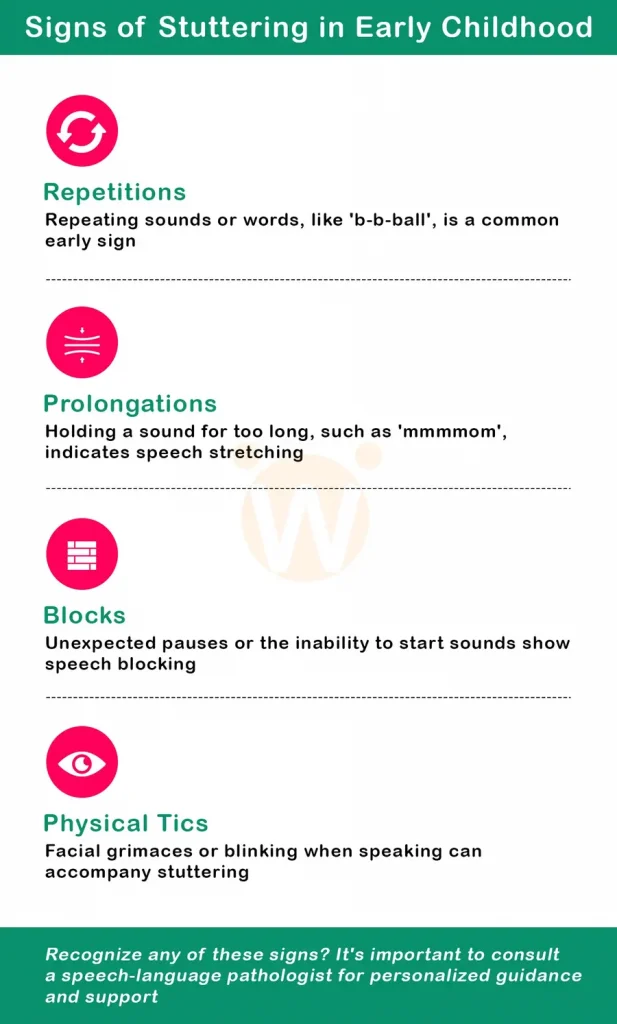
As we continue our journey into understanding stuttering in early childhood, it’s crucial to recognize when it’s time to move from observation to action. Knowing the signs of stuttering in preschoolers can empower you as a parent to seek the right support at the right time. But what exactly should you be looking for? And what causes stuttering in young children?
Warning Signs of Persistent Stuttering in Preschoolers
Stuttering involves more than the occasional stumble over words that we all experience. Here are some warning signs that the stuttering may be persistent:
- Repetitions: This is one of the most common signs, where a child repeats words or parts of words more than twice, like “I-I-I want that.”
- Prolongations: The child stretches out a sound for a long time, such as “Sssssometimes we go out.”
- Blocks: Pauses or blocks happen when the child seems to get stuck and can’t get the word out at all.
- Physical Tics: You might notice facial grimacing, blinking, or other body movements when you are trying to speak.
- Avoidance: The child may start avoiding speaking or certain situations where they have to talk.
- Frustration: A noticeable increase in frustration or sensitivity about speaking.
Also Read: Early Identification/ Warning Signs in child development.
What Causes Stuttering in Young Children?
Stuttering can be attributed to a variety of factors, making it a complex issue. Genetics play a significant role; children who have family members who stutter are more likely to stutter themselves. Neurophysiology, or how a child’s brain processes language, can also contribute, as can family dynamics and communication styles. While the exact cause of stuttering in each child can vary, these factors can interplay to affect speech fluency.
When to Be Concerned
If your child is showing several of these signs consistently over a period of 3-6 months, it may be time to consult with a speech-language pathologist (SLP). Early intervention can make a significant difference in managing stuttering effectively.
Remember, every child’s development is unique. Some children may go through phases of disfluency that are a normal part of learning to speak. However, if you notice persistent stuttering signs as described above, it’s a good idea to seek professional advice.
The Role of Parents in Supporting Their Stuttering Child
Navigating the waters of parenting is challenging, especially when it involves supporting a child who stutters. The role you play is pivotal, not just in recognizing the early signs of stuttering but also in providing an environment that nurtures confidence and eases communication. Here, we explore how parents can support a stuttering child, offering practical tips to create a supportive home atmosphere.
Creating a Supportive Home Environment
Listen Patiently and Attentively: One of the most powerful ways you can support your child is by listening attentively to what they have to say without interrupting or finishing sentences for them. Your patience sends a message that their voice is valued, encouraging them to express themselves freely.
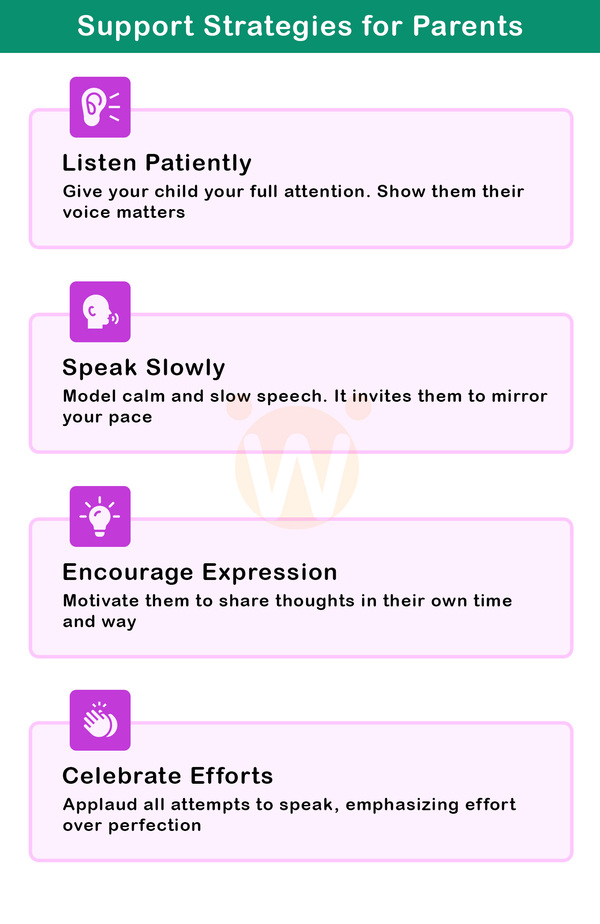
- Maintain a Relaxed Pace of Life: A calm and unhurried environment can reduce pressure on your child to speak quickly. Slow down your own speech, demonstrating that it’s okay to take time to form thoughts and words. This practice not only helps in reducing speech pressure but also models a relaxed speech pattern for your child to emulate.
- Celebrate Efforts, Not Just Fluency: Acknowledge and praise your child for their communication attempts, regardless of stuttering. Celebrate their efforts and courage in expressing themselves. This positive reinforcement can boost their self-esteem and reduce any anxiety associated with speaking.
- Simplify Your Language: Use simple, concise sentences and encourage the same from everyone in the family. This approach can lessen the linguistic load on your child, making it easier for them to join conversations and express their thoughts.
- Foster Open Communication About Stuttering: Create an environment where stuttering can be discussed openly without stigma or embarrassment. This openness helps demystify stuttering for your child and allows them to share their feelings and experiences.
- Encourage Turn-Taking in Conversations: Promote a family communication style where everyone takes turns to speak. This practice ensures your child feels they have a safe space and ample time to express themselves without being rushed or overshadowed.
- Reduce Stressors: Identify and minimize situations that may cause stress or anxiety for your child, as these can exacerbate stuttering. Cultivating a peaceful and supportive home atmosphere can help your child feel more relaxed and confident in their speech.
Daily Speech Support Activities for Children
| Activity Name | Description | Goal of Activity |
|---|---|---|
| Mirror Practice | Encourage your child to speak or read aloud in front of a mirror to observe facial movements and expressions. | Enhance self-awareness and confidence in speaking. |
| Breath Control Games | Play games that involve controlling breath, such as blowing on windmills or bubbles. | Improve breath support for speech. |
| Storytelling Time | Set aside a daily quiet time for your child to tell a story or describe a drawing they made. | Foster creative expression and fluency. |
| Turn-Taking Conversations | Practice taking turns in conversation during family meals or game time, using a toy or object as a “talking stick.” | Teach patience in conversation and reduce pressure to speak quickly. |
| Singing Together | Sing simple songs together, focusing on rhythm and clear articulation of words. | Utilize melody and rhythm to improve speech fluidity. |
| Listening Time | Dedicate time to listen to your child without any distractions, showing interest and encouragement. | Validate their efforts and encourage communication. |
| Positive Reinforcement Jar | Create a jar where you add a token or note for every effort your child makes to communicate, regardless of fluency. | Build confidence and reward communication attempts. |
Emphasizing Early Recognition and Support
Early recognition of stuttering signs and proactive support are key. Consulting with speech-language pathologists (SLPs) can provide you with tailored strategies and interventions suited to your child’s needs. Wellness Hub emphasizes the importance of early intervention, offering resources and professional guidance to support your child’s journey towards fluent communication.
Remember, your support, understanding, and encouragement are invaluable to your child’s development and confidence. By implementing these best practices for parents of children who stutter, you’re not only helping to improve their speech fluency but also bolstering their self-esteem and communication skills for life.
Learn more about on What are the Tips for Parenting an Autistic Child?
Treatment Options and When to Seek Professional Help
Empowering your child to navigate the challenges of stuttering involves more than just understanding and support—it’s about taking action through practical, everyday strategies and exercises. These techniques are designed to enhance your child’s speech fluency and confidence in a comfortable, familiar setting: your home.
Simple Strategies and Exercises for Home
- Slow and Steady Speaking: Model slow, deliberate speech when talking with your child. This technique reduces the pressure to respond quickly, allowing them time to formulate their thoughts and words more comfortably.
- Pausing for Effect: Introduce natural pauses in your conversations. This not only aids in reducing the speed of your speech but also gives your child a clear signal that it’s okay to take their time when speaking.
- Mirror Exercises: Spend a few minutes each day practicing speaking in front of a mirror with your child. This can help them become more aware of their facial movements and encourage relaxation while speaking.
- Breath Control Games: Incorporate fun activities that focus on controlling breath, such as blowing bubbles or balloons. This helps in teaching your child how to control their breathing, a vital aspect of smooth speech.
- Storytelling Sessions: Create a daily routine where your child can tell a story in a relaxed environment. Encourage them to narrate their day or make up a story, focusing on expressing themselves without the pressure of being fluent.
- Positive Reinforcement: Celebrate all attempts at communication, emphasizing the content of what they’re saying over how fluently they say it. This reinforces the value of their thoughts and feelings, building confidence.
- Turn-taking Games: Engage in games that naturally require taking turns to speak. This not only makes conversation more manageable but also instills patience and listening skills.
Read more on Best Online Speech Therapy for Kids
Empowering Your Child Through Understanding
Understanding that stuttering is just one aspect of your child’s communication skills is crucial. Highlight their strengths in other areas, whether it’s in writing, art, or non-verbal communication. This broad view helps your child see beyond their stuttering, recognizing their full potential in various forms of expression.
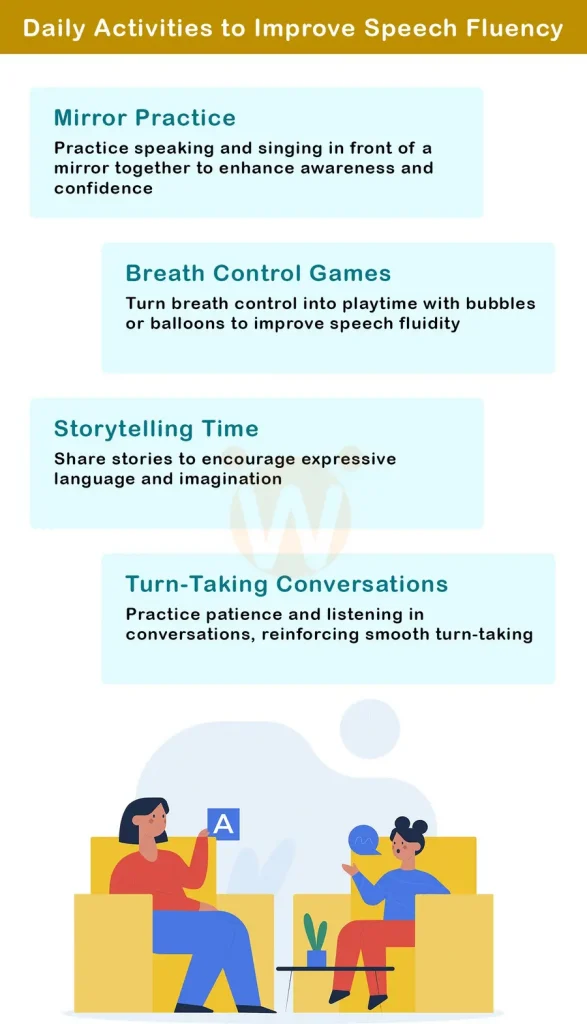
Creating a Supportive Environment
Remember, the goal of these exercises isn’t to eliminate stuttering overnight but to build a foundation of confidence and skills that your child can rely on. By integrating these simple, actionable strategies into your daily routine, you’re not only supporting your child’s speech development but also reinforcing the message that they are heard, understood, and valued.
Conclusion
Navigating the journey of supporting a child with stuttering in early childhood can be challenging, but armed with the right information and strategies, you can make a significant difference. It’s crucial to recognize the early signs of stuttering, understand its impacts, and implement supportive measures at home. These steps, including patient listening, encouraging slow speech, and engaging in turn-taking conversations, create a nurturing environment that fosters confidence and ease in communication.
If stuttering persists, seeking professional help from a speech-language pathologist is essential. These specialists offer personalized strategies and interventions, helping your child improve their speech fluency. Remember, early intervention is key to effectively managing stuttering, and professional guidance can provide the support your child needs to navigate their speaking challenges successfully.
Wellness Hub is here to support you through this journey, offering resources and expert advice to guide you and your child toward a path of clear and confident communication. By embracing a supportive role and seeking the right help when needed, you can empower your child to overcome their stuttering challenges, ensuring they have the tools and confidence to express themselves freely.
Frequently Asked Questions
1. What are the first signs of stuttering in a child?
The first signs of stuttering in a child can include frequent repetition of sounds, syllables, or words, prolongations of sounds, and noticeable pauses or blocks in their speech. Other early indicators might involve physical signs of struggle when speaking, like blinking or lip quivering.
2. How can I help my preschooler with stuttering at home?
Helping your preschooler with stuttering at home involves creating a supportive and patient communication environment. Speak slowly and clearly, encourage turn-taking in conversations, and listen attentively without interrupting. Engage in activities that promote smooth speech, such as storytelling or singing, and praise all efforts to communicate, emphasizing the content over fluency.
3. When should I seek professional help for my child’s stuttering?
Consider seeking professional help if your child’s stuttering persists for 6 months or more, interferes with their ability to communicate or causes them frustration or anxiety. Early evaluation by a speech-language pathologist can provide you with strategies tailored to your child’s needs and help manage stuttering more effectively.
4. Can stuttering in early childhood be cured?
While there’s no one-size-fits-all “cure” for stuttering, many children see significant improvement or even overcome stuttering with early intervention, personalized speech therapy, and supportive home practices. The goal of the intervention is to enhance fluency, boost confidence, and improve communication skills.
5. What causes stuttering in young children?
Stuttering in young children can be caused by a combination of factors, including genetics, neurophysiology, and environmental influences. While the exact cause varies from child to child, stuttering often results from differences in how the brain processes language and speech.
6. Are there any activities that can improve my child’s fluency?
Yes, there are several activities that can improve your child’s fluency, including reading aloud together, practicing slow and rhythmic speech through singing, and engaging in relaxed conversation times where the child feels no pressure to speak quickly. Speech therapy exercises provided by a professional can also be practiced at home to enhance fluency.
7. How does stuttering in early childhood affect a child’s emotional well-being?
Stuttering can impact a child’s emotional well-being, leading to feelings of frustration, embarrassment, or anxiety about speaking. It’s important for parents and caregivers to provide emotional support, encourage open communication about feelings, and foster a positive self-image to mitigate these effects.
8. Can technology assist in helping children with stuttering?
Yes, technology can assist in helping children with stuttering. There are various speech therapy apps and tools designed to improve fluency and confidence through engaging exercises and games. However, these should complement, not replace, traditional speech therapy and parental support.
9. What role do schools play in supporting children with stuttering?
Schools play a crucial role in supporting children with stuttering by fostering an inclusive and understanding environment. Teachers and speech therapists within the school can work together to provide tailored support, make accommodations in class participation and presentations, and educate peers about stuttering to promote empathy and reduce stigma.
10. How can parents create a positive and supportive communication environment at home?
Parents can create a positive environment by using slow, clear speech, encouraging turn-taking in conversations, and showing patience and understanding. It’s also beneficial to celebrate efforts to communicate, focus on what the child is saying rather than how they’re saying it, and provide a safe space for them to express emotions and frustrations related to stuttering.
About the Author:
Rajini, M.Sc., Speech-Language Pathologist (9+ years of experience)
Rajini is a passionate and dedicated Speech-Language Pathologist with over 9+ years of experience, specializing in both developmental speech and language disorders in children and rehabilitation in adults. Driven by a desire to empower each individual to find their voice, Rajini brings a wealth of experience and a warm, genuine approach to therapy.
Currently, at Wellness Hub, she thrives in a team environment that values innovation, compassion, and achieving results for their clients.
Connect with Rajini to learn more about how she can help you or your loved one find their voice.
Book your Free Consultation Today
Parent/Caregiver Info:
Client’s Details:
* Error Message


